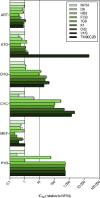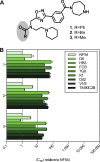Identification and deconvolution of cross-resistance signals from antimalarial compounds using multidrug-resistant Plasmodium falciparum strains
- PMID: 25487796
- PMCID: PMC4335906
- DOI: 10.1128/AAC.03265-14
Identification and deconvolution of cross-resistance signals from antimalarial compounds using multidrug-resistant Plasmodium falciparum strains
Abstract
Plasmodium falciparum, the most deadly agent of malaria, displays a wide variety of resistance mechanisms in the field. The ability of antimalarial compounds in development to overcome these must therefore be carefully evaluated to ensure uncompromised activity against real-life parasites. We report here on the selection and phenotypic as well as genotypic characterization of a panel of sensitive and multidrug-resistant P. falciparum strains that can be used to optimally identify and deconvolute the cross-resistance signals from an extended panel of investigational antimalarials. As a case study, the effectiveness of the selected panel of strains was demonstrated using the 1,2,4-oxadiazole series, a newly identified antimalarial series of compounds with in vitro activity against P. falciparum at nanomolar concentrations. This series of compounds was to be found inactive against several multidrug-resistant strains, and the deconvolution of this signal implicated pfcrt, the genetic determinant of chloroquine resistance. Targeted mode-of-action studies further suggested that this new chemical series might act as falcipain 2 inhibitors, substantiating the suggestion that these compounds have a site of action similar to that of chloroquine but a distinct mode of action. New antimalarials must overcome existing resistance and, ideally, prevent its de novo appearance. The panel of strains reported here, which includes recently collected as well as standard laboratory-adapted field isolates, is able to efficiently detect and precisely characterize cross-resistance and, as such, can contribute to the faster development of new, effective antimalarial drugs.
Copyright © 2015, American Society for Microbiology. All Rights Reserved.
Figures



Similar articles
-
A 2-amino quinoline, 5-(3-(2-(7-chloroquinolin-2-yl)ethenyl)phenyl)-8-dimethylcarbamyl-4,6-dithiaoctanoic acid, interacts with PfMDR1 and inhibits its drug transport in Plasmodium falciparum.Mol Biochem Parasitol. 2014 Jun;195(1):34-42. doi: 10.1016/j.molbiopara.2014.05.006. Epub 2014 Jun 8. Mol Biochem Parasitol. 2014. PMID: 24914817
-
Assessment of Plasmodium falciparum resistance to ferroquine (SSR97193) in field isolates and in W2 strain under pressure.Malar J. 2006 Feb 7;5:11. doi: 10.1186/1475-2875-5-11. Malar J. 2006. PMID: 16464254 Free PMC article.
-
Antiplasmodial activity of new 4-aminoquinoline derivatives against chloroquine resistant strain.Bioorg Med Chem. 2014 Jul 15;22(14):3573-86. doi: 10.1016/j.bmc.2014.05.024. Epub 2014 May 20. Bioorg Med Chem. 2014. PMID: 24906512
-
[Mechanisms and dynamics of drug resistance in Plasmodium falciparum].Bull Soc Pathol Exot. 1999 Sep-Oct;92(4):236-41. Bull Soc Pathol Exot. 1999. PMID: 10572658 Review. French.
-
Transporters as mediators of drug resistance in Plasmodium falciparum.Int J Parasitol. 2010 Aug 15;40(10):1109-18. doi: 10.1016/j.ijpara.2010.04.001. Epub 2010 Apr 24. Int J Parasitol. 2010. PMID: 20399785 Review.
Cited by
-
Gossypol is a natural product with good antimalarial activity against Plasmodium falciparum clinical isolates.Sci Rep. 2025 Jan 9;15(1):1469. doi: 10.1038/s41598-025-85643-6. Sci Rep. 2025. PMID: 39789096 Free PMC article.
-
Use of a highly specific kinase inhibitor for rapid, simple and precise synchronization of Plasmodium falciparum and Plasmodium knowlesi asexual blood-stage parasites.PLoS One. 2020 Jul 16;15(7):e0235798. doi: 10.1371/journal.pone.0235798. eCollection 2020. PLoS One. 2020. PMID: 32673324 Free PMC article.
-
Antiplasmodial dihetarylthioethers target the coenzyme A synthesis pathway in Plasmodium falciparum erythrocytic stages.Malar J. 2017 May 15;16(1):192. doi: 10.1186/s12936-017-1839-3. Malar J. 2017. PMID: 28502250 Free PMC article.
-
A Method for Amplicon Deep Sequencing of Drug Resistance Genes in Plasmodium falciparum Clinical Isolates from India.J Clin Microbiol. 2016 Jun;54(6):1500-1511. doi: 10.1128/JCM.00235-16. Epub 2016 Mar 23. J Clin Microbiol. 2016. PMID: 27008882 Free PMC article.
-
Genetic complexity alters drug susceptibility of asexual and gametocyte stages of Plasmodium falciparum to antimalarial candidates.Antimicrob Agents Chemother. 2024 Mar 6;68(3):e0129123. doi: 10.1128/aac.01291-23. Epub 2024 Jan 23. Antimicrob Agents Chemother. 2024. PMID: 38259087 Free PMC article.
References
-
- Noor AM, Kinyoki DK, Mundia CW, Kabaria CW, Mutua JW, Alegana VA, Fall IS, Snow RW. 2014. The changing risk of Plasmodium falciparum malaria infection in Africa: 2000-10: a spatial and temporal analysis of transmission intensity. Lancet 383:1739–1747. doi:10.1016/S0140-6736(13)62566-0. - DOI - PMC - PubMed
Publication types
MeSH terms
Substances
LinkOut - more resources
Full Text Sources
Other Literature Sources
Molecular Biology Databases
Research Materials

